| Introduction |
| Environmental Issues in LA |
| Mexico |
| Central America |
| Caribbean |
| Guiana Highlands |
| Andean Region |
| Brazil |
| Southern Cone |
| Future |
Colombia
The economy of Colombia depends primarily
on agriculture and manufacturing. With its great mountains, mining
has become a larger and larger profitable source of income. Colombia
holds over 90% of all the emeralds in the world, as well as major deposits
of petroleum, coal, natural gas and iron. Thus Colombia deals with
oil drilling and mining environmental problems. Although mining is a very
profitable source of income, often the means of mining out the emeralds
and other heavy metals and raw materials are not so profitable to the environment.
Although mining companies claim to be environmentally safe, better and
stricter regulations regarding environmentally safe mining need to be put
in place to ensure the survival of the enviornment.
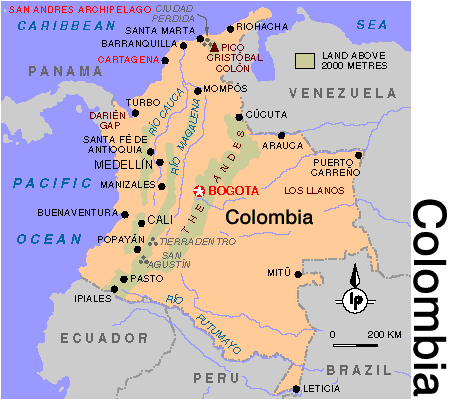
Links:
Environment:
Ecuador and Colombia to seek Regional Dialogue
http://www.oneworld.org/ips2/aug98/23_38_100.html
This article explores the issues and decisions
which came up out of a conference between environment ministers of Colombia
and Ecuador. They discussed issues such as reforestation, oil drilling
and cleaning up polluted rivers.
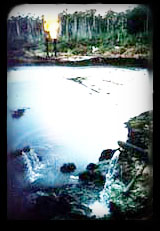
Image courtesy of Beyond Oil
Campaign
Beyond
Oil Campaign
http://www.ran.org/ran/ran_campaigns/beyond_oil/oil.html
This site offers information on environmental
and indigenous issues dealing with oil drilling in Colombia, Ecuador and
Peru.
TED
Case Studies: Coca, Trade and Environment
http://gurukul.ucc.american.edu/TED/COCA.HTM
This case study deals with the production
of cocaine and its environmental and cultural impact in Colombia, Ecuador,
Peru and Bolivia. It deals with the fact that were coca production
completely eliminated, the poorer indigenous people would be left without
a great source of their income. However, the production of cocaine
uses large amounts of pesticides, deforestation occurs to make room for
more crops, and toxic chemicals are dumped either onto the ground or into
the rivers. The case also explores economic incentives and alternative
crop production to make the production of coca less profitable.
Ecuador
Ecuador in composed of lowlands, the Andes
mountains and the Galapagos Islands. Manufacturing, mining and agriculture
are extremely important in the Ecuadorian economy, as is fishing (mainly
shrimp). Ecuador faces problems such as forest destruction and oil
drilling issues. Ecuadaor must deal with over-fishing and water contamination
which destroy its shrimp population, one of Ecuador's major means of subsistence.
With so much coast, islands and mountains the only economic means for many
of its citizens is to either fish (which leads to over-fishing of the population)
or work in the mines which are pften harmfiul to the workers due to the
mining methods as well as dust and debris which not only pollute the air
but also the lungs of the workers. Another means of existence needs to
be found to help the people of Ecuador realize how important sustaining
the environment is; not only for environment's sake, but for their own
well-being.

Links:
Ecuadorian
Environmentalism
http://weber.u.washington.edu/~ahalpern/adam.html
This website looks into oil industry spills
and related problems such as forest destruction. It also looks at
the importance of the shrimp industry and the impact it is having on the
mangrove ecosystem; and the page explores the deterioration of the Galapagos
Islands.
Peru
Peru consists of a coast, highlands and
forests and jungles. Fishing, farming (either on personal plots of
land or on cooperative farms) and mining of copper, silver and zinc.
One of Peru’s major environmental problems arise from the oil drilling
and mining industries.
One such mine in Cajamarca, Peru is a series of gold mines owned by a Colorado-based American mining company, Newmont Mining Corporation. Newmont, although professing its environment-friendly mining techniques and bringing jobs and money into the area is a facade. Newmont says it is environmentally friendly because it does not ruin the top-soil of the beautiful Andes mountain chain. Instead, they remove the trees and topsoil and then commence their mining, thereby creating a topless mountain, an eyesore as you scan the mountains surrounding the valley. Newmont has created jobs for the people of Cajamarca: true, although they work long hours days at a time with only a fifteen minute break for lunch. Newmont Corp. uses cyanide gold-mining techniques in its mines in Yanacocha, Peru. This means “washing” the dirt dug up from the mountains with a cyanide mixture to force the tiny pieces of gold out. The used cyanide is dumped into a basin, the bottom of which is covered by a thick plastic, which they say will never leak and is guaranteed to last for twenty-five years. But what happens after those twenty-five years are up, you ask? They will not answer this. The one thing they are adamant about is the fact that the plastic will never leak, that even when the put the top back on the mountain over the cyanide-filled plastic and it rains, the ground water will be safe.
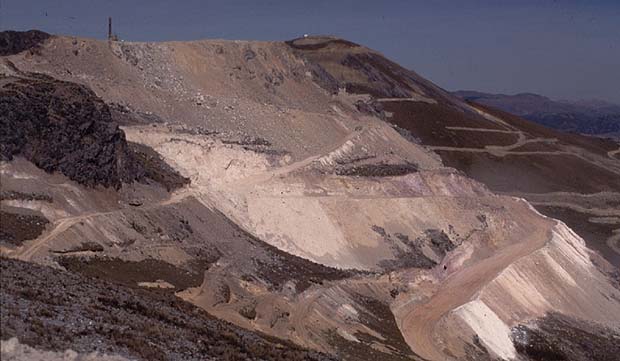
Image courtesy of Newmont
Mining Corporation
But even now the water is not safe.
The people of Cajamarca say that the water tastes different, that there
has been a rise in diseases such as leukemia, which however are not yet
determined as related. One of the environmental laws which mining
countries much follow it testing of the ground water by an outside source.
So Newmont, a rich American company gets the water tested – not from the
source which runs off the mountain, but from another river which branches
off of the sources miles  into
Cajamarca, and they say that the water is perfectly fine. However,
a group in Cajamarca suspected differently, and tested the water in another
stream, not the source, and came up with alarming results: various mineral
deposits, heavy metals such as iron and magnesium and the pH of the water
were much higher than normal or even safe amounts. Unfortunately,
testing water costs a lot of money, and the people of Cajamarca cannot
afford to have their water tested at every site which comes off of the
mountain. The mining company has more leeway with them Peruvian government
than the people do because that is where the money is coming from.
And no one knows if the water problem will get worse after the twenty-five
year guarantee or once the top is put back on the mountain.
into
Cajamarca, and they say that the water is perfectly fine. However,
a group in Cajamarca suspected differently, and tested the water in another
stream, not the source, and came up with alarming results: various mineral
deposits, heavy metals such as iron and magnesium and the pH of the water
were much higher than normal or even safe amounts. Unfortunately,
testing water costs a lot of money, and the people of Cajamarca cannot
afford to have their water tested at every site which comes off of the
mountain. The mining company has more leeway with them Peruvian government
than the people do because that is where the money is coming from.
And no one knows if the water problem will get worse after the twenty-five
year guarantee or once the top is put back on the mountain.
For more information, here is Newmont
Mining Corporation’s website:
http://www.newmont.com/
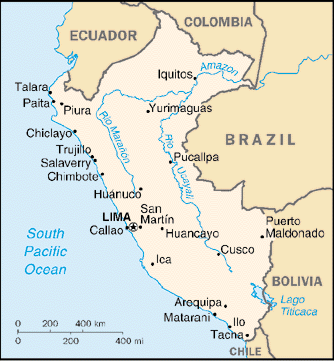
Shell
Oil Under Renewed Attack for Human Rights Abuses
http://forests.org/gopher/general/shelloil.txt
This is an article relating the problem
Shell Oil is having with Indigenous peoples in Peru and in Nigeria with
drilling on lands traditionally used for other purposes.
Bolivia
Bolivia, a land-locked country located in
the middle of South America, is also in the Andes chain. This country
also deals with deforestation, soil erosion, air and water pollution as
its major environmental issues. Factories in Bolivia dupm toxic waste
into their water system, contaminating fish habitats and drinking water
alike. Although the government has created laws to curb this environmental
destruction, much more stringent laws and punishments need to be taken
against companies who contaminate the environment. Obviously the
threats already in existence are not doing enough in this country.

Links:
Environment
– Bolivia: First Lawsuit On Environmental Damages
http://www.tbwt.com/articles/gin2/gin817.htm
This page talks about the first case in
Bolivia dealing with environmental damages caused in that country.
On August 4, 1998 the Guabira sugar mill went on trial for dumping waste
into the Piari river, killing over 80 tons of fish from the pollution.
Bolivia:
Strategy for Danish-Bolivian Development Cooperation
http://www.um.dk/english/udenrigspolitik/udviklingspolitik/landestrategier/bolivia/bolivia.4.5.htm
This page discussed the various environmental
issues which have recently plagued Bolivia. It mentions problems
with deforestation, soil erosion, water and air pollution. The author
also mentions the Ministry for Sustainable Development and the Environment
which was recently adopted in Bolivia.
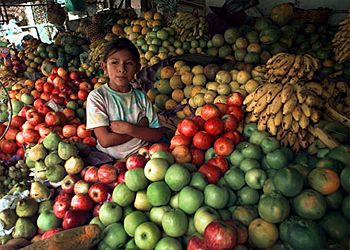
Image courtesy of: Discovery Channel Online:
http://www.discovery.com/exp/bolivia/zooms/980424zoom2.html
Sources:
Ecuador
http://city.net/img/tra/mag/map/ecuado.gif
The Perry-Castañeda Library Map Collection
http://www.lib.utexas.edu/Libs/PCL/Map_collection/peru.html
The Lonely Planet
http://www.lonelyplanet.com.au/dest/sam/graphics/map-bol.htm
The Lonely Planet
http://www.lonelyplanet.com.au/dest/sam/graphics/map-col.htm